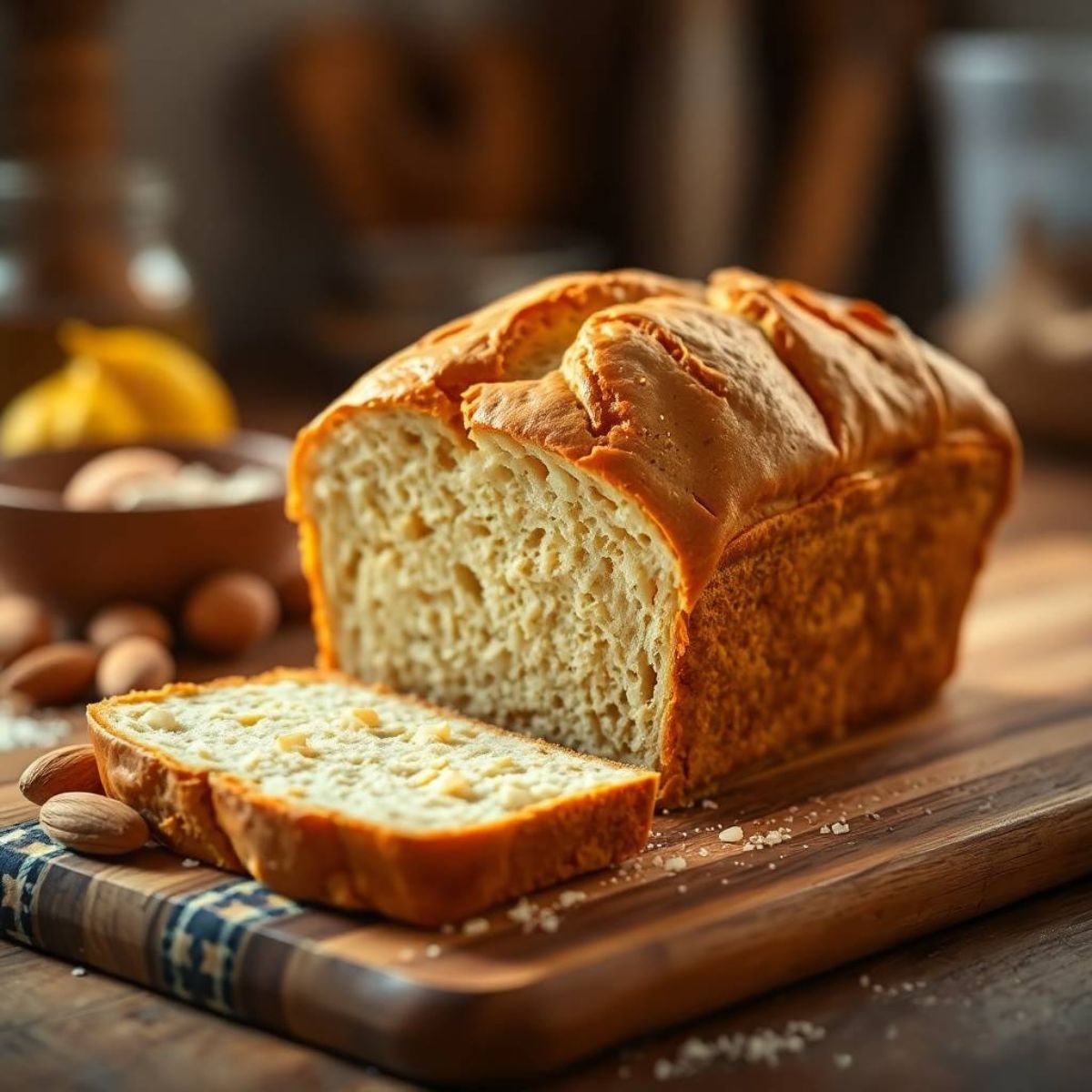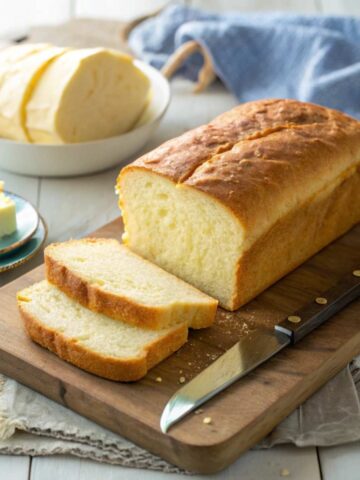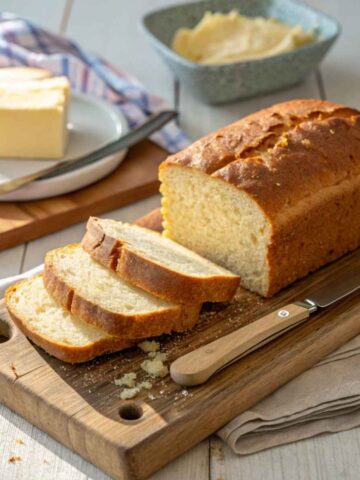gluten-free bread has become a staple in the lives of many, thanks to its role in supporting those with specific dietary needs. Whether you're following a gluten-free lifestyle for health reasons or exploring alternative options to wheat-based bread, this recipe is a game-changer.

People with celiac disease or gluten sensitivity rely on gluten-free bread to avoid adverse reactions, but it's not just for them. Many others choose this option for its potential digestive benefits or to experiment with new flavors and ingredients.
However, baking gluten-free bread at home is often seen as a challenge. From achieving the right texture to ensuring it tastes great, creating gluten-free bread that rivals traditional loaves is no small feat. But worry not—this guide will walk you through every step to craft the perfect gluten-free bread.
Jump to:
- What Makes a Bread Gluten-Free?
- Health Benefits of gluten-free bread
- Common Challenges in Making gluten-free bread
- Step-by-Step gluten-free bread Recipe
- Pro Tips
- Nutritional Profile of gluten-free bread
- Comparing gluten-free bread to Regular Bread
- Popular Variations of gluten-free bread
- FAQs About gluten-free bread
- Conclusion
What Makes a Bread Gluten-Free?
2.1 Definition
gluten-free bread is crafted without gluten, a protein found in wheat, barley, and rye. Gluten is what gives traditional bread its elasticity and chewy texture, but it can cause serious health issues for individuals with celiac disease or gluten sensitivity.
In gluten-free bread, the absence of gluten is replaced with alternative ingredients and techniques that replicate its structure and texture. Consequently, this enables people to enjoy bread without compromising their health or dietary needs.
2.2 Ingredients That Replace Gluten
Creating gluten-free bread involves making innovative substitutions to replicate the structural role of gluten. For instance, here are the key components commonly used in gluten-free bread recipes:
- Gluten-Free Flours: Almond flour, rice flour, sorghum flour, and tapioca flour are popular choices. Each type of flour brings its unique flavor and texture to the bread.
- Binding Agents: Without gluten, bread can fall apart easily. Xanthan gum and psyllium husk are used to bind ingredients together and create a cohesive dough.
- Moisture Enhancers: Ingredients like eggs, applesauce, or yogurt are often added to improve the bread's texture and prevent it from being dry or crumbly.
These elements combine to create a loaf that not only looks like bread but also has the softness, rise, and taste people love.
Health Benefits of gluten-free bread
gluten-free bread offers numerous health benefits, particularly for individuals who cannot tolerate gluten or are seeking alternative options for their diet. Here are some of the most notable advantages:
3.1 Digestive Benefits
For those with celiac disease or non-celiac gluten sensitivity, consuming gluten-free bread is essential. Gluten can trigger symptoms like bloating, diarrhea, and abdominal pain. Switching to gluten-free bread alleviates these issues and supports overall gut health.
3.2 Reduced Inflammation
Gluten sensitivity can lead to inflammation in the body, especially in the intestines. gluten-free bread helps minimize these inflammatory responses, contributing to better overall health and comfort.
3.3 Suitability for Diverse Dietary Needs
gluten-free bread is a versatile option for various dietary preferences. It's commonly adapted for:
- Low-carb diets: By incorporating flours like almond or coconut flour.
- Vegan lifestyles: Using plant-based substitutes like flaxseed or chia seeds for binding instead of eggs.
3.4 Nutrient-Rich Alternatives
Many gluten-free flours, such as quinoa, sorghum, and teff, offer additional nutrients like fiber, protein, and essential minerals that traditional wheat flour may lack.
While gluten-free bread may not be inherently "healthier" for everyone, it provides an indispensable solution for those needing or choosing a gluten-free lifestyle.
Common Challenges in Making gluten-free bread
Baking gluten-free bread is a rewarding endeavor, but it comes with unique challenges. Understanding these hurdles and how to overcome them can help you craft the perfect loaf.
4.1 Dough Texture Differences
One of the most noticeable differences in gluten-free bread dough is its texture. Unlike traditional dough, which is elastic and easy to knead, gluten-free dough tends to be sticky and batter-like. This can be surprising for beginners, but it's entirely normal.
Solution:
Focus on mixing thoroughly rather than kneading. Using a stand mixer can make the process smoother and more efficient.
4.2 Rise and Density Issues
Gluten provides the structure that traps air and allows bread to rise. Without it, gluten-free bread may turn out dense or fail to rise properly.
Solution:
- Use binding agents like xanthan gum or psyllium husk to mimic gluten's structure.
- Ensure the yeast is activated correctly by proofing it with warm water and sugar.
4.3 Flavor Considerations
Gluten-free flours often have distinct flavors, which, unlike the neutral taste of wheat, can make the bread taste different. As a result, it might seem unusual to those who are used to traditional bread.
Solution:
Combine different gluten-free flours to balance flavors, and add ingredients like honey, herbs, or seeds to enhance the taste.
4.4 Moisture Retention
gluten-free bread is prone to dryness, which can make it crumbly and less appealing.
Solution:
To keep your gluten-free bread fresh, you can start by adding moisture-retaining ingredients such as yogurt, applesauce, or olive oil to the recipe. Furthermore, storing it properly in airtight containers also helps preserve its freshness.
Mastering these challenges will set the foundation for baking gluten-free bread that rivals any traditional loaf in texture and taste.
Step-by-Step gluten-free bread Recipe
Making gluten-free bread at home is easier than you think. Follow this detailed recipe to create a loaf that's soft, flavorful, and perfect for any occasion.
5.1 Ingredients List
Here’s what you’ll need for a basic gluten-free bread recipe:
- Dry Ingredients:
- 2 ½ cups gluten-free all-purpose flour (with xanthan gum included)
- 1 teaspoon salt
- 2 tablespoons sugar
- 1 tablespoon baking powder
- Wet Ingredients:
- 1 ¼ cups warm water (around 110°F)
- 2 ¼ teaspoons active dry yeast (1 packet)
- 3 tablespoons olive oil or melted butter
- 2 large eggs
- Optional Add-Ins:
- 1 teaspoon apple cider vinegar (for softness)
- Seeds (sunflower, sesame, or chia) for added texture and flavor
5.2 Equipment Needed
Gather the following tools for an efficient baking experience:
- Stand mixer or hand mixer with dough hooks
- Large mixing bowl
- Measuring cups and spoons
- Loaf pan (8x4 or 9x5 inches)
- Parchment paper
- Kitchen thermometer
5.3 Preparation Instructions
- Activate the Yeast
- In a small bowl, combine the warm water and sugar. Sprinkle the yeast on top and let it sit for 5–10 minutes until it becomes frothy.
- Prepare the Dry Ingredients
- In a large mixing bowl, whisk together the gluten-free flour, salt, and baking powder.
- Combine Wet Ingredients
- In another bowl, mix the eggs, olive oil, and apple cider vinegar (if using).
- Mix the Dough
- Slowly pour the yeast mixture and wet ingredients into the dry ingredients. Use a stand mixer or hand mixer to combine until the dough is smooth and sticky.
- Shape the Dough
- Line your loaf pan with parchment paper. Pour the dough into the pan, smoothing the top with a spatula. Sprinkle optional seeds on top for added texture.
- Allow to Rise
- Cover the pan loosely with a kitchen towel and let the dough rise in a warm place for 30–45 minutes or until it doubles in size.
- Bake the Bread
- Preheat your oven to 375°F (190°C). First, bake the bread for 35–40 minutes, or until the top turns golden brown. Then, check if it’s done by inserting a toothpick into the center; it should come out clean.
- Cool and Serve
- Let the bread cool in the pan for 10 minutes before transferring it to a wire rack. Allow it to cool completely before slicing.
Pro Tips
Making gluten-free bread as good as traditional bread needs a few simple changes. These tips will help make your bread tasty, soft, and just right.
6.1 Storing gluten-free bread
Proper storage is key to maintaining the freshness of your gluten-free bread. Unlike regular bread, gluten-free loaves tend to dry out faster.
- Short-Term Storage: Keep your bread in an airtight container at room temperature for up to 2 days.
- Long-Term Storage: Slice the bread and store it in the freezer. Wrap slices individually to make defrosting easy.
6.2 Substitutions for Dietary Preferences
If you’re catering to specific dietary needs, here are some substitution tips:
- Vegan Option: Replace eggs with a flaxseed or chia seed mixture (1 tablespoon seeds + 2.5 tablespoons water per egg).
- Low-Fat Option: Substitute olive oil with unsweetened applesauce for a lighter loaf.
6.3 Enhancing Texture and Flavor
gluten-free bread can sometimes lack the elasticity and flavor of its wheat-based counterparts. Here’s how to elevate it:
- Add Sweetness: Use a touch of honey or maple syrup in your recipe for a natural sweet flavor.
- Incorporate Moisture: Ingredients like yogurt, mashed bananas, or sour cream can improve the texture.
- Experiment with Flours: Combining multiple flours, like almond and sorghum, provides a more complex flavor profile.
6.4 Baking Adjustments
- Use a Thermometer: Ensure your bread is fully baked by checking that the internal temperature reaches 200°F (93°C).
- Don’t Overproof: Gluten-free doughs are delicate and may collapse if left to rise for too long.
By applying these tips, you’ll consistently bake gluten-free bread that’s moist, delicious, and bakery-quality.
Nutritional Profile of gluten-free bread
Understanding the nutritional composition of gluten-free bread is crucial for making informed dietary choices. To illustrate, here's a breakdown of the typical nutrients found in a standard gluten-free bread recipe.
7.1 Caloric Content
gluten-free bread often has a bit more calories than regular bread, mainly because it uses rich flours like almond or coconut flour.
- Calories per Slice: Approximately 100–150 calories, depending on the ingredients used.
7.2 Macronutrient Composition
- Carbohydrates: gluten-free bread is typically rich in carbs, with an average of 20–25 grams per slice. This makes it an energy-dense option for those needing a quick boost.
- Protein: Thanks to flours like almond or quinoa, gluten-free bread provides 3–5 grams of protein per slice, which is slightly higher than traditional bread.
- Fats: The use of oils or butter adds healthy fats, contributing around 2–4 grams per slice.
7.3 Key Nutrients
gluten-free bread often incorporates alternative flours and seeds that enhance its nutritional profile:
- Fiber: Ingredients like psyllium husk or flaxseeds can provide 2–3 grams of fiber per slice, aiding digestion.
- Vitamins and Minerals: Depending on the recipe, gluten-free bread can include:
- Vitamin E from almond flour
- Iron from sorghum or teff flour
- Magnesium from chia seeds
7.4 Reduced Additives
Homemade gluten-free bread often lacks the preservatives and artificial additives found in store-bought versions, making it a healthier option for clean eating.
While gluten-free bread is generally nutrient-rich, it is important to practice portion control, particularly for individuals monitoring their carbohydrate intake or caloric consumption.
Comparing gluten-free bread to Regular Bread
gluten-free bread offers unique characteristics and benefits compared to traditional wheat-based bread. Understanding these differences can help you appreciate the nuances of both.
8.1 Texture and Taste Differences
One of the most noticeable distinctions is the texture and flavor profile of gluten-free bread.
- Texture:
- gluten-free bread is denser and more crumbly due to the lack of gluten's elasticity.
- Wheat-based bread tends to be soft and chewy.
- Taste:
- gluten-free bread often has a nutty or earthy flavor, depending on the flours used.
- Traditional bread has a neutral, slightly sweet flavor profile.
8.2 Nutritional Advantages and Disadvantages
- Advantages of gluten-free bread:
- Made from nutrient-dense flours like almond or quinoa, providing extra vitamins and minerals.
- Lower in preservatives when homemade.
- Disadvantages of gluten-free bread:
- Slightly higher in calories and fats due to ingredients like oils and nut-based flours.
- However, it may lack the fiber content of whole-grain wheat bread unless, for instance, it is enriched with psyllium husk or seeds.
8.3 Suitability for Dietary Needs
gluten-free bread, on the one hand, is essential for individuals with celiac disease or gluten intolerance. On the other hand, traditional bread is ideal for those without gluten sensitivities and who are seeking a cost-effective, versatile option.
8.4 Shelf Life and Storage
- gluten-free bread:
- Prone to drying out quickly due to the absence of gluten. Freezing is often necessary to extend its shelf life.
- Regular Bread:
- Stays fresh for longer when stored at room temperature, thanks to the structural stability provided by gluten.
Choosing between gluten-free and traditional bread largely depends on personal dietary needs and flavor preferences. Meanwhile, both have their merits; however, gluten-free bread serves as an invaluable alternative for those avoiding gluten.
Popular Variations of gluten-free bread
gluten-free bread is incredibly versatile and, moreover, can be easily adapted to suit different tastes and preferences. For example, here are some popular variations you can try making at home.
9.1 Sweet Bread Variations
Adding a touch of sweetness can transform gluten-free bread into a delightful treat.
- Banana Bread:
- Incorporate mashed bananas and a sprinkle of cinnamon for a naturally sweet and moist loaf.
- Perfect for breakfast or as a snack.
- Pumpkin Bread:
- Add pumpkin puree and spices like nutmeg and ginger for a seasonal favorite.
- Ideal for autumn gatherings.
9.2 Savory Bread Variations
Savory gluten-free breads pair well with soups, salads, or as a sandwich base.
- Herbed Focaccia:
- Infuse your bread with rosemary, thyme, and olive oil for an aromatic twist.
- Sprinkle sea salt on top before baking for extra flavor.
- Cheese and Jalapeño Bread:
- Mix shredded cheese and diced jalapeños into the dough for a spicy kick.
- Serve warm for the best experience.
9.3 Ethnic Bread Variations
Explore global flavors by experimenting with these cultural adaptations:
- Gluten-Free Naan:
- Made with yogurt and gluten-free flour, naan is perfect for curries and dips.
- Cornbread:
- A Southern classic that’s naturally gluten-free when made with cornmeal.
- Add a touch of honey for sweetness or jalapeños for heat.
9.4 Bread for Special Diets
Customize your bread for unique dietary needs:
- Vegan Bread:
- Replace eggs with flax or chia seed gel and use plant-based milk.
- Low-Carb Bread:
- Incorporate almond or coconut flour to reduce carb content while keeping it delicious.
Experimenting with these variations ensures you’ll never get bored with gluten-free bread. From sweet treats to savory sides, there’s a recipe for every occasion.
FAQs About gluten-free bread
10.1 What is gluten, and why is it avoided?
Gluten is a protein found in wheat, barley, and rye, and it gives bread its elasticity and chewy texture. However, for people with celiac disease or gluten sensitivity, avoiding gluten is essential to prevent health issues such as digestive problems, inflammation, and nutrient malabsorption.
10.2 Can I use regular yeast for gluten-free bread?
Yes, regular active dry yeast or instant yeast can be used for gluten-free bread. However, ensure it is certified gluten-free to avoid cross-contamination.
10.3 How long does gf bread last?
Homemade gluten-free bread, for instance, stays fresh at room temperature for 2–3 days when stored in an airtight container. Additionally, for longer storage, you can freeze the bread in slices for up to 3 months.
10.4 Is gluten-free bread healthier than regular bread?
Not necessarily. Although gluten-free bread is essential for individuals with gluten intolerance, it may, on the other hand, contain more calories or fats depending on the ingredients used. Moreover, the nutritional value varies based on the recipe.
10.5 Can I freeze gluten-free bread?
Yes, freezing is one of the best ways to preserve gluten-free bread. Slice the loaf before freezing, and wrap each slice individually for easy defrosting.
10.6 What are the best gluten-free bread brands?
Popular gluten-free bread brands include Schär, Udi’s, and Canyon Bakehouse. They offer a variety of options for different tastes and textures.
10.7 What are the key ingredients in gluten-free bread?
gluten-free bread typically includes alternative flours (like almond, rice, or sorghum), binding agents (xanthan gum or psyllium husk), and moisture enhancers (eggs or yogurt).
10.8 Can I find gluten-free bread in supermarkets?
Yes, most supermarkets now carry gluten-free bread. Look for it in the health food aisle or in designated gluten-free sections.
10.9 Where can I find gluten-free bread nearby?
Many bakeries, grocery stores, and online retailers offer gluten-free bread. Apps like Yelp or Google Maps can help locate options near you.
10.10 What is the best gluten-free bread recipe?
The best recipe depends on your taste preferences and dietary needs. The step-by-step recipe provided above is a versatile and delicious starting point.
Conclusion
Baking gluten-free bread at home may seem challenging, but with the right ingredients, techniques, and tips, it can be an incredibly rewarding experience. This comprehensive guide has covered everything you need to know, from understanding what makes bread gluten-free to mastering a detailed step-by-step recipe.
gluten-free bread provides a healthy and delicious alternative for those with celiac disease, gluten sensitivity, or simply a desire to explore new flavors. Moreover, by addressing common challenges and experimenting with variations, you can create loaves that, in turn, rival traditional bread in both taste and texture.
Whether you prefer a classic loaf, a savory herb focaccia, or even a sweet banana bread, gluten-free baking not only opens the door to endless possibilities but also offers a delightful journey of creativity and flavor. Remember to store your bread properly, adapt recipes to suit dietary preferences, and enjoy the satisfaction of crafting homemade gluten-free bread.
Now, it’s your turn to get started! First, gather your ingredients, then preheat your oven, and finally, begin baking. Additionally, don’t forget to share your results and, in doing so, inspire others to embrace the gluten-free lifestyle!





Leave a Reply